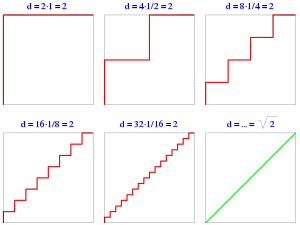
In mathematical analysis, the staircase paradox is a pathological example showing that limits of curves do not necessarily preserve their length.[1] It consists of a sequence of "staircase" polygonal chains in a unit square, formed from horizontal and vertical line segments of decreasing length, so that these staircases converge uniformly to the diagonal of the square.[2] However, each staircase has length two, while the length of the diagonal is the square root of 2, so the sequence of staircase lengths does not converge to the length of the diagonal.[3][4] Martin Gardner calls this "an ancient geometrical paradox".[5] It shows that, for curves under uniform convergence, the length of a curve is not a continuous function of the curve.[6]
For any smooth curve, polygonal chains with segment lengths decreasing to zero, connecting consecutive vertices along the curve, always converge to the arc length. The failure of the staircase curves to converge to the correct length can be explained by the fact that some of their vertices do not lie on the diagonal.[7] In higher dimensions, the Schwarz lantern provides an analogous example showing that polyhedral surfaces that converge pointwise to a curved surface do not necessarily converge to its area, even when the vertices all lie on the surface.[8]
As well as highlighting the need for careful definitions of arc length in mathematics education,[9] the paradox has applications in digital geometry, where it motivates methods of estimating the perimeter of pixelated shapes that do not merely sum the lengths of boundaries between pixels.[10]
See also
- Coastline paradox, similar paradox where a straight segment approximation diverges
- Aliasing, a more general phenomenon of inaccuracies caused by pixelation
- Cantor staircase, a fractal curve along the diagonal of a unit square
- Taxicab geometry, in which the lengths of the staircases and of the diagonal are equal
References
- ↑ Moscovich, Ivan (2006), Loopy Logic Problems and Other Puzzles, New York: Sterling Publishing, p. 23, ISBN 9780486490694
- ↑ Farrell, Margaret A. (February 1975), "An intuitive leap or an unscholarly lapse?", The Mathematics Teacher, 68 (2): 149–152, doi:10.5951/mt.68.2.0149, JSTOR 27960047
- ↑ Sedaghat, H. (2022), Real Analysis and Infinity, Oxford University Press, p. 9, ISBN 9780192895622
- ↑ Stewart, Ian (2017), "Diagonal of a square", Infinity: A Very Short Introduction, Oxford University Press, pp. 43 & 54, ISBN 9780191071515
- ↑ Thompson, Silvanus P.; Gardner, Martin (1998), "Appendix: Some recreational problems related to calculus", Calculus Made Easy, Palgrave, pp. 296–325. See pp. 305–306.
- ↑ Sinitsky, Ilya; Ilany, Bat-Sheva (2016), Change and Invariance: A Textbook on Algebraic Insight into Numbers and Shapes, Sense Publishers, pp. 375–376, doi:10.1007/978-94-6300-699-6, ISBN 978-94-6300-699-6
- ↑ Krantz, Steven G. (2010), "15.1: How to measure the length of a curve", An Episodic History of Mathematics: Mathematical Culture Through Problem Solving, MAA Textbooks, Washington, DC: Mathematical Association of America, pp. https://books.google.com/books?id=ulmAH-6IzNoC&pg=PA249, ISBN 978-0-88385-766-3, MR 2604456
- ↑ Ogilvy, C. Stanley (1962), "Note to page 7", Tomorrow's Math: Unsolved Problems for the Amateur, Oxford University Press, pp. 155–161
- ↑ Bennett, Albert A. (February 10, 1920), "Limit proofs in geometry", The Texas Mathematics Teachers' Bulletin, 5 (2): 12–22; see especially p. 16
- ↑ Klette, Reinhard; Yip, Ben (2000), "The length of digital curves", Machine Graphics and Vision, 9 (3): 673–703